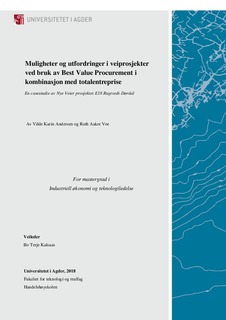| dc.description.abstract | Nye Veiers project E18 Rugtvedt-Dørdal is the first project in Norway to use the procurement method Best Value Procurement. The project is carried out as a Design-Build contract, which also is fairly new in the road construction industry. The purpose of this thesis is to reveal how Nye Veiers new project execution model has influenced the project execution phase, regarding cooperation, constructability and customer value. This will be discussed in the context of theories regarding transaction costs, the principal-agent problem, network in value chains and learning. The study is based on an abductive approach which combines inductive and deductive approach, and has been carried out as a case study. Both qualitative and quantitative methods is used to provide comprehensive evidence. Propositions have been used to create a link between theory and empirical data, and the study seeks to confirm or reject the following propositions: 1) the BVP method provides increased customer value compared to traditional procurement methods, 2) the combination of BVP and a Design-Build contract provides better constructability and faster project execution compared to a traditional Design-Build contract, and 3) BVP principles such as low emphasis on price and high emphasis on performance are not effected upstream in the value chain.
Several of the BVP mechanisms provides preconditions for increased customer value compared to traditional procurement methods. A BVP offer contains additional values and risk assessment for the customer, which results in a more customer oriented focus. Using a Design-Build contract makes the entrepreneur responsible for both design and engineering. This enables simultaneous engineering and construction, which can result in production-friendly solutions. BVP ensures that the contractor gets involved before the contract is signed, and the customer and contractor meet in a clarification phase where the offer is explained in detail. Constructability is achieved by using a Design-Build contract, but the clarification phase in BVP adds preconditions for further improving the constructability. BVP principles imply a low focus on price and an increased focus on performance, but findings indicate that this focus is not existing upstream in the value chain. After signing the contract with the customer, the contractor can re-negotiate with its subcontractors. Overall, the findings indicate that the project execution model has elements which provides preconditions for increased constructability and value for the customer. However, the BVP method has some structural weaknesses because of the lacking focus on performance upstream in the value chain. The cooperation in the project is well functioning, but data does not reveal whether this is a consequence of the project execution model or due to contextual conditions. | nb_NO |

